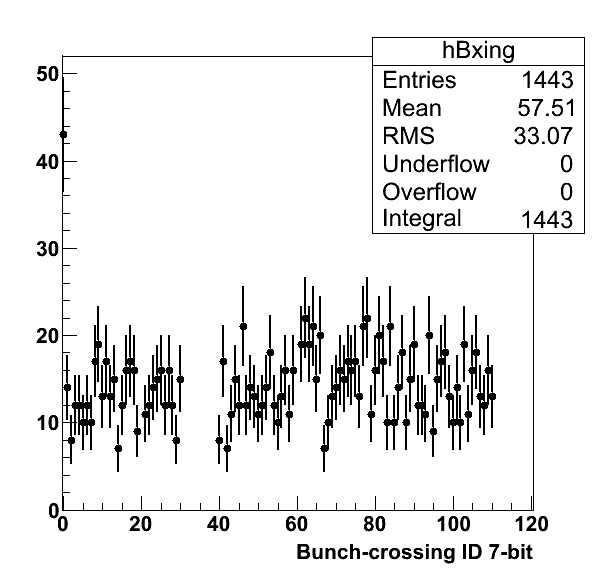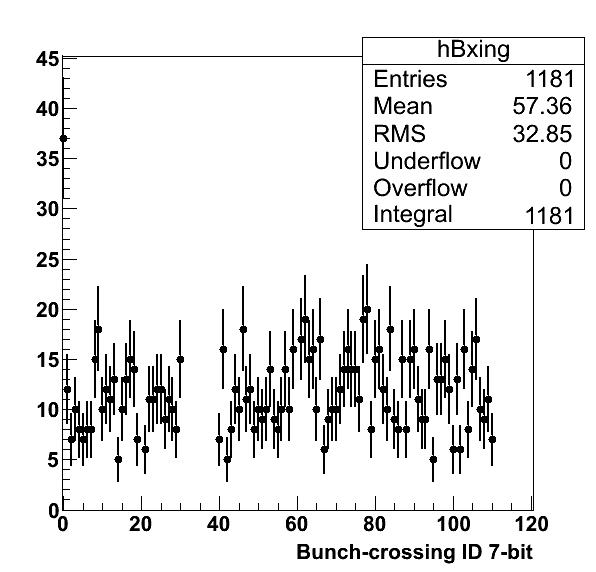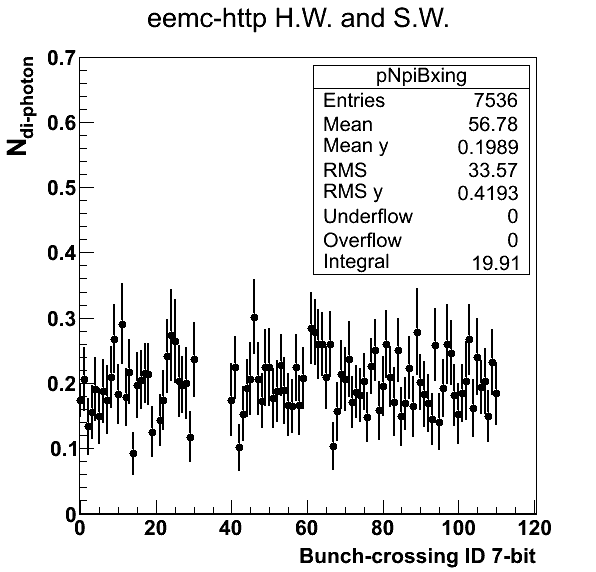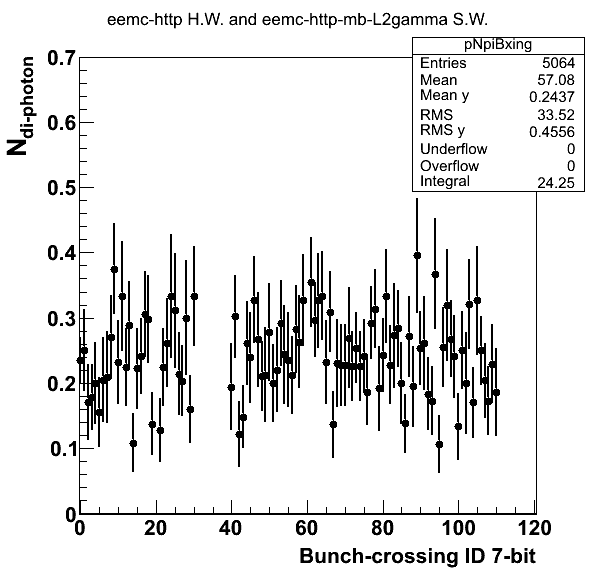- drach09's home page
- Posts
- 2022
- 2020
- June (1)
- 2019
- 2018
- 2017
- 2016
- 2015
- 2014
- December (13)
- November (2)
- October (5)
- September (2)
- August (8)
- July (9)
- June (7)
- May (5)
- April (4)
- March (4)
- February (1)
- January (2)
- 2013
- December (2)
- November (8)
- October (5)
- September (12)
- August (5)
- July (2)
- June (3)
- May (4)
- April (8)
- March (10)
- February (9)
- January (11)
- 2012
- 2011
- October (1)
- My blog
- Post new blog entry
- All blogs
2006 EEMC Neutral Pions: Single-beam Backgrounds (part 3)
Remaining items on my single-beam background wish-list are to examine the mass distribution for events without a BBC-coincidence, quantify the percentage which pass our cuts, and examine the φ-dependence as well as possible asymmetry. A major issue appears to be isolating the !(BBCE&&BBCW) events within the trees. I attempted to do this with the following procedure:
- Run the code enforcing eemc-http triggers in hardware (H.W.) and software (S.W.)
- Run the code enforcing eemc-http triggers in hardware and eemc-http-mb-L2gamma in software
- Subtract the two samples to isolate the no-coincidence events
One potential problem, of course, is the effect of the L2gamma enforcement in the software. However, it appears that the software trigger enforces nothing concerning the min-bias condition.
Figure 1
| eemc-http H.W. and S.W. | eemc-http H.W. and eemc-http-mb-L2gamma S.W. |
|---|---|
.png) |
.png) |
| Di-photon Events | |
| eemc-http H.W. and S.W. | eemc-http H.W. and eemc-http-mb-L2gamma S.W. |
 |
 |
In Fig. 1 I show the bunch-crossing distribution for all events (top) and di-photon events (bottom). On the left, I have required the eemc-http hardware and software trigger. On the right, I have required the eemc-http hardware trigger and eemc-http-mb-L2gamma software trigger. In each one can see the empty abort gaps and kicked bunches and the spike at ID-0. In the true eemc-http-mb-L2gamma distributions, no such effect is observed. My belief at this time is that the spike at ID-0 is due to abort gap and kicked bunch events being defaulted into ID-0. If this is true, since abort gap and kicked bunch events are mostly (not entirely) from !(BBCE&&BBCW) events, I do not believe, the software trigger is effectively enforcing the BBC-coincidence requirement. All of the event losses would then be due to the L2gamma feature. If this is true, then, I do not know off-hand how to isolate the !(BBCE&&BBCW) events from the trees.
Fitting a constant to the distributions above ID-0, I find on average 72.12±0.85 events per ID in eemc-http H.W. and S.W. and 48.28±0.70 events per ID in eemc-http H.W. and eemc-http-mb-L2Gamma S.W. If I assume the true ID-0 events contain the average, then, that would leave 192.88±16.30 abort-gap/kicked-bunch events in eemc-http H.W. and S.W. and 121.72±13.06 abort-gap/kicked-bunch events in eemc-http H.W. and eemc-http-mb-L2Gamma S.W. Assuming the vast majority of these are from the blue-beam abort-gap/kicked-bunches, this would imply a ratio of filled-to-unfilled ID events near 4-to-1. This seems a bit high, but perhaps this is the result of the higher software thresholds or just rounding issues on my end.
Figure 2


In Fig. 2, I show the mean number of di-photons for each bunch-crossing ID. The distributions are rather constant, even for ID-0. Constant fits return 0.189442±0.00466277 with χ2/ν = 88.023/99 for eemc-http hardware and software triggers and 0.227977±0.00609472 with χ2/ν = 106.249/99 for eemc-http hardware and eemc-http-mb-L2gamma software triggers. So, one sees a slight increase in the rate of di-photon events as one moves to eemc-http-mb-L2gamma in the software, however, not as large an increase as I might expect for the enforcement of the min-bias requirement. Additionally, I am somewhat surprised that ID-0 appears to vary not at all from the other ID's. This is not exactly what I would expect for a high presence of abort-gap/kicked-bunch events. It is possible, of course, that a SBB event lands as a spray of junk which will return two "photons" in the reconstruction; and perhaps this is the observed effect.
One other possible check is to examine the distribution of events from ID-0. In the event one observes the gross features from early posts, one might get an idea of the influence of these events in our measurement.
Figure 3


In Fig. 3 I post the phi and mass distribution of ID-0 events. One observes 46 (left) and 40 (right) di-photons of which 29 (left) and 26 (right) fall within the nominal signal window of 0.1 < mγγ < 0.2 GeV/c2. The events do not seem to be biased toward the top hemisphere of the detector, where one might expect a single-beam background event. ID-0 does not appear to be remarkable in any way from other ID's except that it is more populated. On average, integrating over events with at least 1 di-photon, a given ID will contain 13.6±0.4 (left) and 10.8±0.3 (right) di-photons. Thus, if one assumes ID-0 is a combination of true ID-0 events and abort gap and kicked bunch events, one can expect something around 32.4±6.8 (left) and 29.2±6.3 (right) abort-gap/kicked-bunch di-photons. If one assumes all of these come from the blue-beam abort-gap/kicked-bunches, this would imply ~3 di-photons in each blue-unfilled ID. So, this would, then, be consistent with a picture of significantly fewer di-photons from unfilled ID's than from filled ID's. However, given that one expects ~193 (left) and ~122 (right) unfilled events, this converts to ~0.168 (left) and ~0.240 (right) di-photons per unfilled ID, which is comparable to what we observe in a filled ID. Further, I'm bothered by the fact that the scatter plots do not appear to signal the SBB behavior observed in my previous update.
This does not smell right to me.
- drach09's blog
- Login or register to post comments
